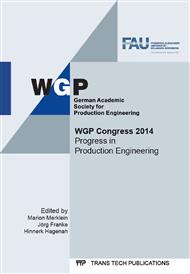p.245
p.253
p.261
p.269
p.277
p.285
p.293
p.301
p.309
Decrease of Springback by Geometrical Modification of the Sheet Metal Part
Abstract:
Super high strength steels are used as the importance of lightweight construction increases. They induce a high amount of springback during removal of a tool and this has to be compensated. Previously developed methods of springback compensation [1] have two disadvantages. Firstly springback of a u-shaped profile cannot be compensated in one deep drawing step. Secondly these methods only take the material parameters of one sheet metal batch into account. With varying material properties, problems arise because the tool is especially designed for one sheet metal batch. Therefore the objective of this work is not to compensate springback but to reduce it by a preventive measure which allows the production of a u-shaped profile by one deep drawing step. An additional advantage of the measure, which consists of a geometric change of the punch radii and is defined by several parameters, is that the influence of the sheet metal batch on springback is significantly reduced. This can be realised by a suitable choice of values for these parameters. Apart from this measure a method was developed whereby appropriate values for the parameters can be determined on the basis of a metamodel without the need of individual simulations. By way of example the method is applied to a u-shaped profile, however it can be used for structural components in general.
Info:
Periodical:
Pages:
277-284
Citation:
Online since:
September 2014
Authors:
Keywords:
Price:
Сopyright:
© 2014 Trans Tech Publications Ltd. All Rights Reserved
Share:
Citation:


